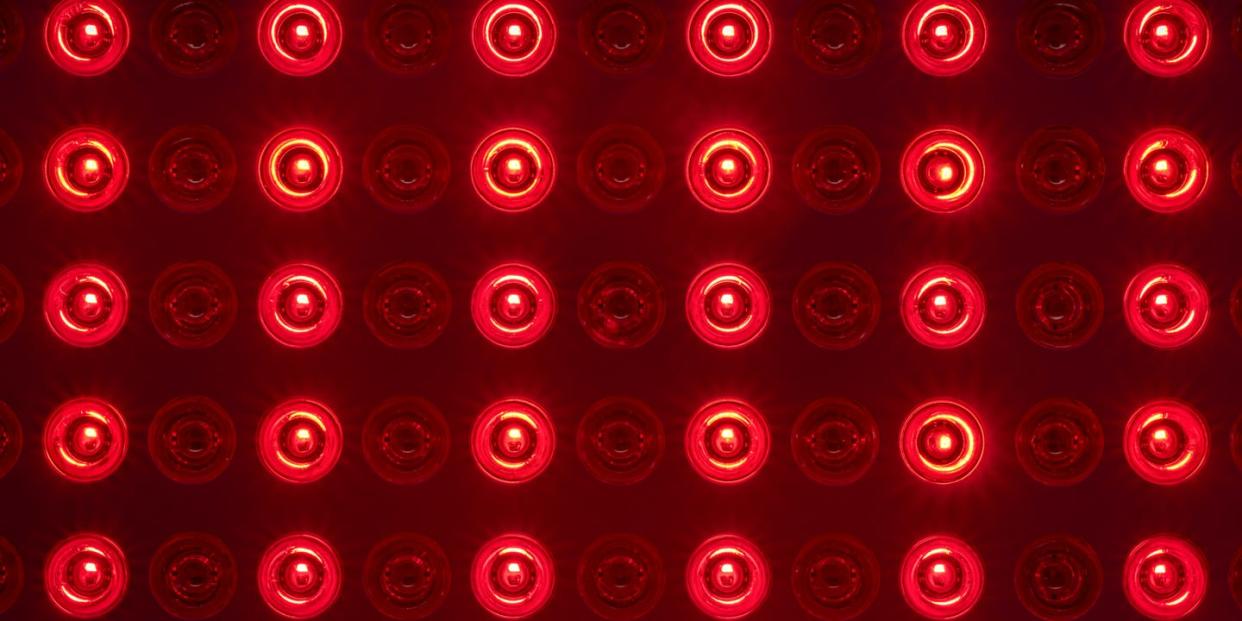This Trendy Treatment Promises To Ease Pain And Boost Muscle Recovery. Here, Experts Reveal If It's Legit.

You’ve seen the celebrities and influencers donning futuristic LED face masks to improve signs of aging and acne. The technology behind it—red light therapy (RLT), which is a form of photobiomodulation, as scientists say—has potential perks that are more than skin-deep.
Elite athletes, for example, hop into specialized red light beds to speed up recovery time. Doctors use it as an adjunct treatment for patients with chronic and acute pain and are hopeful it may help curb the amount of opioids they prescribe post-op.
Experts believe red light energizes your cells and makes them function
better. Just as plants convert light into energy, so can you, says Robert Bowen, MD, a physician in West Virginia who has been using the modality to treat patients for 20 years.
Should you jump under the ruby-hued rays? Here’s what the pros say.
Meet the experts: Robert Bowen, MD, is a West Virginia-based physician specializing in cosmetic and regenerative medicine. Juanita Anders, PhD, is a researcher at Uniformed Services University, the nation’s federal health professions academy. Soorena Khojasteh, MD, is the director of pain medicine at Lankenau Medical Center in Pennsylvania.
Red light therapy could level up athletic performance and recovery—just ask your favorite athletes.
Not only can RLT potentially help you recover faster after a workout, but it may help prevent some muscle soreness in the first place. Researchers found that RLT decreases levels of an enzyme responsible for aches and muscle damage after a sweat sesh and prevents its activity at the outset.
This is why RLT beds can be found in professional sports training rooms. But even if you’re not a pro, the energy red light provides to your cells should improve athletic performance overall, says Dr. Bowen, who uses RLT for 15 minutes before and after he works out. The method has also been found to decrease lactic acid and increase circulation, says Juanita Anders, PhD, a researcher at Uniformed Services University, the nation’s federal health professions academy—kind of like the West Point for health sciences. (Btw, even the military is invested in RLT research because of its potential to help soldiers perform and recover better.)
While some studios offer exercise classes under a red light, some experts say you won’t see many benefits from this because you’re not getting close enough to the light, and it’s best to sit still for it anyway.
It may also heal inflammatory pain and swelling.
RLT has been found to change the expression of genes that lead to an inflammatory reaction, shifting them from a pro-inflammatory state to an anti-inflammatory one. It can also help regulate a reaction in either direction—turning up inflammation when it’s needed or turning it down if it’s problematic. Cool! It addresses pain by speeding up the healing process instead of just masking it.
Essentially, as long as the light can reach the target site effectively (think surface-level issues such as bug bites, burns, rashes, or cuts), RLT should help an inflammatory reaction. Hence why RLT first became popular in the skin-care world: Skin is super easy for light to reach. Deeper-tissue inflammatory pain such as arthritis is tougher to treat with a red light, but in a clinical setting with a stronger laser, photobiomodulation should be able to offer relief, says Soorena Khojasteh, MD, director of pain medicine at Lankenau Medical Center in Pennsylvania.
The treatment can also boost the rate of fluid removal along lymphatic tracks to decrease swelling, even treating lymphedema in breast cancer patients. And while it can help with the kind of swelling that happens when you sprain your ankle, it’s worth noting that it likely won’t address swelling caused from extra sodium, kidney problems, or congestive heart failure, says Dr. Bowen.
But red light therapy isn't necessarily a cure-all.
Doctors and scientists are hopeful about how far it can go—from skin care and the athletic field to chronic-pain management and even another possible frontier: the brain. Still, a lot of challenges remain. The biggest one is that unless you’re receiving RLT from a doctor, it’s hard to know if the device you’re using is effective. While FDA approval is required for panels, wraps, lamps, and other forms of red light, there isn’t a good way to determine whether a product is strong enough to work before you buy it. Luckily, the treatment itself isn’t dangerous—meaning the biggest risk in purchasing one of these devices is to your wallet.
Overall, there’s still more to study here, including which wavelengths can treat different concerns, and why exactly it works in the first place. “Every year, we’re finding out new things,” Dr. Bowen says. “We knew that it helped 20 years before we had any idea what the mechanisms were.”
How To Optimize Your Red Light Therapy Sessions
If you buy a red light device, give yourself the best shot at feeling the benefits with these tips.
Get as close as you can to the light source. Docs even put lights directly in contact with skin, but consult the instructions for your device before trying this at home.
Do three sessions a week, spending 15 to 20 minutes under the light each time.
Make sure the light reaches the target. If you’re sitting in front of a panel, rotate your body after 15 minutes, and wear minimal clothing.
Use it ASAP for the best results. If you twist your ankle, get under the red light right away.
Talk to your doctor, too. With limited info available about reliable retail products, it’s best to consult your provider about this treatment.
You Might Also Like
